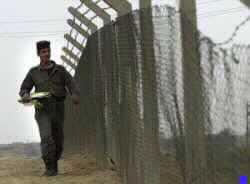U.N.-mandated inspectors revisited an Iraqi nuclear facility and an industrial complex Monday, hours after Baghdad's official declaration on weapons of mass destruction arrived at U.N. headquarters in New York. Experts from the International Atomic Energy Agency drove to al-Tuweitha nuclear facility, 12 miles south of the Iraqi capital, and two other sites. The Tuweitha Nuclear Research Center was inspected twice last week.
Tuweitha is the location of the Osirak reactor bombed by Israel in 1981, and several tons of uranium have been kept under an IAEA seal there since 1998.
Amir al-Saadi, an adviser to President Saddam Hussein, said Iraq handed over the full documentation on its nuclear program to the IAEA as part of the arms declaration demanded by U.N. Security Council resolution 1441 in November, which threatens Iraq with "serious consequences" if it failed to comply. He said it was the IAEA's job to decide how close Iraq had come to making a bomb.
"If I tell you we were close, it is subjective," he said.
But he listed the progress the country had made.
"We have the complete documentation from design to all the other things," he said. "We haven't reached the final assembly of a bomb nor tested it."
Inspectors took samples from al-Tuweitha's radioactive treatment facility, the sewage system and nearby hills. The number of inspectors, about 16, was almost double the number during the last inspection.
The team also started to take a physical inventory of nuclear materials from Tuweitha, which are the last known remnants of a past nuclear program.
"They visited many places that they visited before," said Dr. Fayez al-Biraqdar, adviser to the Iraqi Atomic Commission.
UNMOVIC and IAEA's spokesman in Baghdad, Yashuhiro Ueki, said IAEA experts used a "wide range of inspection techniques ... from visual inspections to sampling for detection of any potential radiological activity using Gamma surveys, water sampling and swipe sampling techniques."
Journalists were not allowed into the site.
Al-Biraqdar said he was prepared to be interviewed by U.N. inspectors any time they liked, but would refuse if he were asked to leave the country for interviews.
"Definitely not, why should I, why should I? ... I am talking now freely. ... This is my country, my people, my family."
EXPLOSIVE MATERIALS
The IAEA inspectors visited two other sites, Ash Shakyli and al Qa Qaa. At Ash Shakyli, they sampled for detection of radiological materials and at al Qa Qaa the experts began an inventory of known explosive materials from the past nuclear program that were previously under IAEA's control.
Another team from the U.N. Monitoring, Verification and Inspection Commission drove to a large military industrial complex linked in the past with Iraq's chemical weapons programs.
The well-guarded Al-Tariq General Company is some 55 miles northwest of Baghdad near the town of Fallujah and run by Iraq's Military Industrialization Commission.
The inspectors spent more than four hours checking the various structures as well as large rusting tanks and containers at the site, which is known as Fallujah 2.
The United States and Britain said earlier this year that Fallujah installations, destroyed in a 1998 military campaign, had been rebuilt and were producing chemical weapons.
Ueki said the Fallujah 2 site contained tagged dual-use equipment that was all accounted for. All key buildings were inspected in addition to the chlorine and phenol plants.
UNMOVIC inspectors examined a nearby pesticides plant Sunday.
Ra'ad Manhal, an Iraqi monitoring official, said the plant produced phenol and chloride for civilian purposes. He said the product was sold to Iraq's water and oil ministries.
"Since it was founded, this factory has not made any weapons of mass destruction," Manhal said. He said the plant was built in 1987 and bombed during the 1991 Gulf War, adding that weapons inspectors had destroyed its equipment in 1997.
"It was later rehabilitated and recommissioned, producing only elements for civilian purposes," Manhal said.
He added seven monitoring cameras planted at the site by a previous inspection team had been removed and stored at the site. He said the inspectors were shown the stored equipment.
U.N. experts got down to work Monday analyzing Iraq's massive declaration on its arms programs.
Twenty-five more U.N. arms inspectors arrived in Baghdad Sunday to reinforce the current team. A spokesman for the inspectors said a further 20 to 30 experts would arrive Tuesday.
PHOTO CAPTION
An Iraqi soldier carrying his food walks along a fence in the Iraqi Nuclear Energy Organization facility in Tuwaitha some 25 kilometers (16 miles) southeast of Baghdad Monday Dec. 9 , 2002 during a visit by U.N. weapons inspectors. (AP Photo/Nasser Nasser)
- Author:
& News Agencies - Section:
WORLD HEADLINES


 Home
Home Discover Islam
Discover Islam Quran Recitations
Quran Recitations Lectures
Lectures
 Fatwa
Fatwa Articles
Articles Fiqh
Fiqh E-Books
E-Books Boys & Girls
Boys & Girls  Hajj Rulings
Hajj Rulings Hajj Fatwas
Hajj Fatwas














